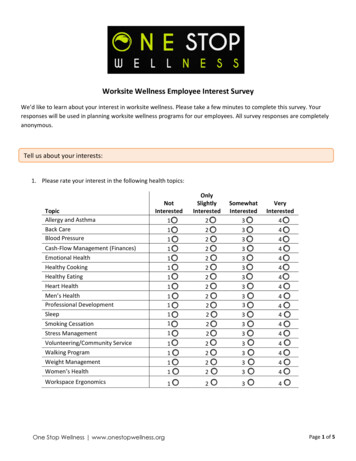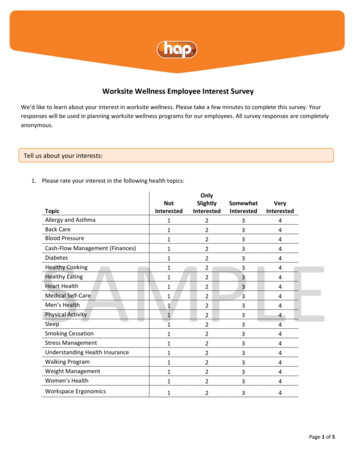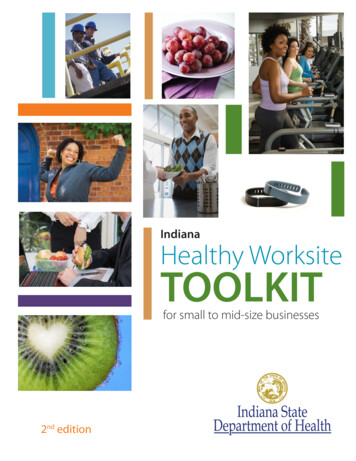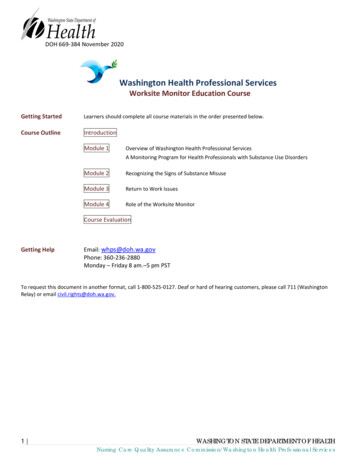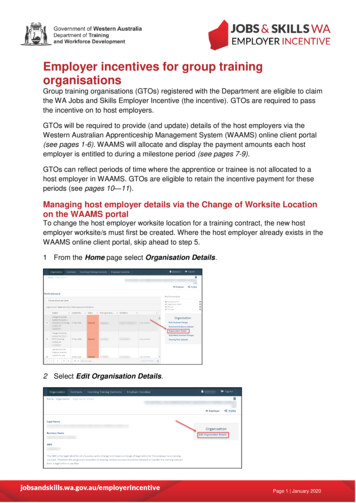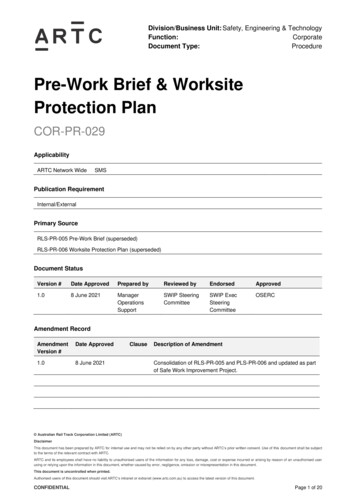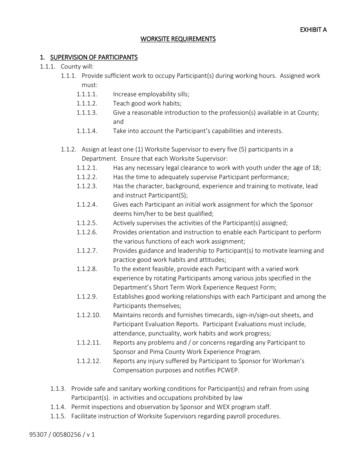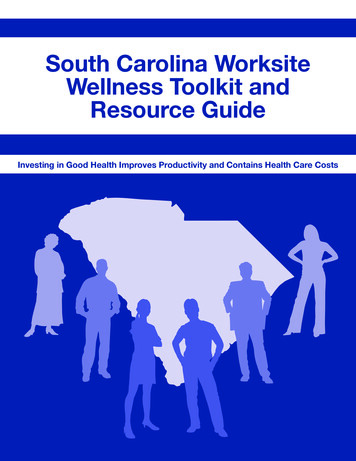
Transcription
South Carolina WorksiteWellness Toolkit andResource GuideInvesting in Good Health Improves Productivity and Contains Health Care Costs
Developed by the Department of Health and Family ServicesDivision of Public HealthWisconsin Nutrition and Physical Activity ProgramModified by the South Carolina Department of Health and Environmental ControlBureau of Community Health and Chronic Disease PreventionDivision of Obesity Prevention and Control, and Heart Disease and Stroke Prevention DivisionFor more information about this resource kit or to obtain a copy,contact:South Carolina Department of Health and Environmental ControlHeart Disease and Stroke Prevention Division1800 St. Julian Place, 4th FloorColumbia, SC 29204Phone: (803) 545-4500Fax: (803) 545-4503E-mail: robinstm@dhec.sc.govVisit our Web site at: http://www.scdhec.gov/hdspSuggested citation:Department of Health and Family Services, Division of Public Health, Nutrition and Physical ActivityProgram, Wisconsin Partnership for Activity and Nutrition. Wisconsin Worksite Resource Kit to PreventObesity and Related Chronic Diseases. September 2007.PPH 40135 (rev. 09/07)2
IntroductionDid you know that in 2007, South Carolina ranked seventh worst for overweight and obesity ratesin the nation? The statistics are staggering: cardiovascular disease is South Carolina’s leadingkiller for both men and women among all racial and ethnic groups; one out of every five adults inour state smokes, and nearly one out of every 10 adults in South Carolina has diabetes.The obese and overweight populations pose a significant economic impact in terms of illness,diseases and lost productivity. As an employer, you may ask yourself What can you do? Youhave the unique opportunity to play a major role in the lives of your employees, by providingsound and responsive health care benefits and implementing worksite wellness initiatives thatprovide access to healthy choices and also support employees to develop and maintain healthybehaviors that can improve productivity, morale, and employee health.This toolkit offers a range of proven strategies and resources to support and enhance healthybehaviors and environments in the work setting. The focus of this resource kit is to changepolicy, systems and environments to reduce risk factors for chronic disease. This toolkit providesworksites with a step-by-step guide to use to assess their worksite, identify the different types ofhealth-promoting strategies that can be implemented, as well as links to additional resources andstrategies to plan, implement and evaluate the effectiveness of your efforts.We know that it will take a commitment on your part to embrace healthier options within yourworkplace, but we also know that you can achieve a positive return on your investment. Byworking together, we are confident that you can establish a setting that is supportive of healthylifestyles, thus leading to a workforce that recognizes your concern and commitment to theirhealth, improved productivity and morale.
Table of ContentsWELCOME . 16 Easy Steps to a Worksite WellnessProgram. . 5What Do I Need to Consider? . 27Narrowing the Scope . 30Action Plan & Worksheet . 31Maintaining Interest & Motivation . 32STEP 6: OUTCOME EVALUATION . 34Sample Evaluation Tools & Measures . 36STEP 1: BUILD SUPPORT FORWORKSITE WELLNESS. 6RISK REDUCTION RESOURCES.37Management Buy-In. 6What is it Going to Cost? .7Hypertension . 39Nutrition .41Physical Activity .46Tobacco .49STEP 2: TAKE THE TEAMAPPROACH . . 10Developing a WorksiteWellness Program .10STEP 3: ASSESS WORKSITE TODRIVE YOUR ACTION PLAN .11Part 1: Worksite Wellness AssessmentChecklist .12Worksite Assessment Checklist(Completed Sample).12Part 2: How to Get Employee Input .14Employee Habits & Interest Survey(Completed Sample).15DISEASE-SPECIFIC RESOURCES.52Arthritis .53Cancer.56Cardiovascular Disease .60Diabetes.64Appendix A:Traumatic Brain Injury . 67Appendix B:Worksite Wellness Assessment Checklist .70Appendix C:Employee Habits & Interest Survey .79Appendix D:Recommendation Table .84Appendix E:Action Plan Worksheet (blank sample).86Part 3: Other Available Data .16Appendix F:Evaluating Health Plans’ Benefits andServices.88STEP 4: SELECT PRIORITIES FORYOUR ORGANIZATION.17Appendix G:Sample Policies .96Worksite Wellness Components .21Health Risk Appraisal.24Appendix H:7 Steps to a Healthier Heart . .98STEP 5: GATHER RESOURCES ANDTOOLS TO DEVELOP ACTION PLAN . 26Appendix I:Coordinator’s Guide . .99
WELCOMEWorksite Wellness: Improve Your Bottom Line and Employee Health WhileContaining Costs Associated with Poor HealthIf you don’t have time to read another manual and areabout to turn away never to return, allow this briefintroduction to convince you otherwise . . . . . . .If We Know That Employees spend approximately 36 percent of their total waking hours at work, More and more employees are becoming overweight from poor eating habits andphysical inactivity, and Heart disease, stroke, cancer, and diabetes are all linked by common risk factorsassociated with poor eating habits, physical inactivity and tobacco use, then As employers, it makes sense for us to get the most out of our employees bycreating a work environment that supports and encourages good health.Employees Who Improve Their Health Can Improve their overall fitness and mental alertness, Enjoy improved morale, Reduce their absenteeism due to sudden illness or chronic health issues, and Live healthier, longer lives.Worksite Wellness Resources Will Help You Identify the strengths and weaknesses of your wellness and health promotionpolicies, Develop an action plan to implement or improve your worksite wellness program,and Provide a multi-faceted payback on your investment.1
What is Worksite Wellness?For the purposes of this resource kit, worksite wellness refers to the education and activities thata worksite may do to promote healthy lifestyles to employees and their families. This resourcekit focuses on risk factors that affect obesity and chronic diseases and does not address safetyissues and injury prevention, which have been regulated and addressed in the worksite.Examples of wellness programming include such things as health education classes, subsidizeduse of fitness facilities, access to healthy food options if food services are provided on-site,policies that promote healthy behavior, and other activities, policies or environmental changesthat support the good health of employees.Why Worksite Wellness?It Affects Your Company’s Bottom Line in Many WaysHere are key factors: Decrease health care costs Increase productivity and employee morale Reduce absenteeism Demonstrate corporate importance and value of a healthyworkforce to achieve goals and profitsIf any or all of these factors are sufficient justification and youalready believe they are likely outcomes of a wellness program,skip right to Step 2. If you need more convincing or backgroundinformation, read on.Health-related concerns arenot only an issue foremployees, but for thenation’s employers, too.Health care premiums havedoubled for the employeeand employer. Employerprofits are being consumedby health care costs. In2000, private businessexpense for health servicesas a percentage of profitwas 40 percent before taxand 58 percent after tax(Cowen, 2002).Rising health care benefit costs are a significant concern andpoor health habits and unnecessary medical care costs consumeportions of corporate resources, as well as the employee paycheck. The worksite is an idealsetting for health education, health promotion and disease prevention programs. Employeesspend many of their waking hours at work. The workplace provides a social network forlearning, behavior reinforcement and support.Why Start a Company Wellness Program?Wellness Programs Help Control CostsAn investment in your employees' health may lower health care costs orslow the increase in providing that important benefit. In fact, employeeswith more risk factors, including being overweight, smoking and havingdiabetes, cost more to insure and paid more for health care than peoplewith fewer risk factors.Wellness programs can besimple or complex. Manyprograms require a minimalinvestment of time andmoney. More substantialprograms often use moreresources, but the manybenefits to supporting andencouraging employeehealth and safety outweighthe costs.An employee wellness program can raise awareness and reinforce goodhealth behaviors, so employees with fewer risk factors remain in alower-cost group. A program also can encourage employees with healthrisk factors to make lifestyle changes, to seek help for physical and mental health problems,improve their quality of life and lower costs. The payoff in dollars as well as in quality of life canhave a big impact on your company’s bottom line. The average cost/benefit ratio for wellnessprograms based on a summary of 28 articles was 3.48 saved per 1 invested (Aldana, 2001). Agood summary analysis of return on investment (ROI) can be found in the issue brief entitledEmployee Health Promotion Programs: What is the Return on Investment? More recent researchgives a much higher return of 6 for every 1 invested (Chapman, 2007 summary, WELCOA,Latest ROI).2
Quick Resource: Employee Health Promotion Programs: What is the Return on lications/issueBriefs/issueBriefv06n05.pdfIncrease ProductivityHealthy employees are more productive. This has beendemonstrated in factory settings and in office environments inwhich workers with workplace wellness initiatives miss lesswork. Presenteeism, in which employees are physicallypresent on the job but are not as productive or effective, isreduced in workplaces that have wellness programs.Direct costs from lost timetotaled nearly 15 on everydollar spent on payroll(Strum, 2002).Reduce AbsenteeismHealthy employees miss less work. Companies that support wellness and healthy decisions havea greater percentage of employees at work every day. Because health frequently carries over intobetter family choices, your employees may miss less work caring for ill family members. Thecost savings of providing a wellness program can be measured against reduced overtime to coverabsent employees and other aspects of absenteeism.Improve Morale and Enhance Image for the OrganizationA company that cares about its employees' health is often seen as a better place to work. Thosecompanies save money by retaining workers who appreciate the benefit of a wellness programand they can attract new employees in a competitive market.Still Not Convinced?The cost to employers of obesity-related health problems in 2003 was 13 billion! This includes 8 billion in medical claims, 2.4 billion in paid sick leave, 1.8 billion in life insurance, andalmost 1 billion in disability insurance. Additionally, an estimated 39 million workdays are lostto obesity-related illnesses each year (DHHS 2004).Here are three quick statistics and the corresponding data on the South Carolina adult workforce: Illness and injury associated with unhealthy lifestyles or modifiable risk factors arereported to account for 25 percent of employee health care expenditures (Anderson,2000). Medical costs attributed to obesity and overweight are estimated to be 395 annually(36 percent) higher than those for normal weight (Strum, 2002). Obese employees are nearly 75 percent more likely to experience higher rates ofabsenteeism (seven or more absences during a six-month period) than normal weightemployees (Tucker, 1998).Percent of Adults with Lifestyle Health Risk FactorsRisk FactorSouth Carolina29%Obese: Body Mass Index (BMI) 3065%Overweight or obese (BMI 25)Diabetes10%Current smoker21.9%High blood pressure30%High cholesterol39%Less than 30 minutes of moderate physical53%activity five or more days per weekLess than five servings of vegetables or fruits81%U. S.26%63%8%20%28%38%50%75%Source: Behavioral Risk Factor Surveillance System (BRFSS)3
The reality is that employers are already paying for health-related issues. On average, acompany can expect to pay an estimated 10,000 per year for things such as: Medical benefits Short and long-term disability Workers compensation Disease management Absence management Staff recruitment and training Human ResourcesMany of the risk factors for chronic diseases are both preventable and modifiable. Most wellnessexperts think and research has shown that between 25 percent and 70 percent of health care costsare potentially avoidable through a well-designed wellness program. Step 2 will provideinformation on getting started and planning what you can do at your worksite.Looking for a Way to Estimate Your Costs and Potential Cost Savings?Obesity, Physical Activity and Chronic Conditions Cost Calculators Magellan Health Services Obesity Cost ervices/obesitycost/default.asp Centers for Disease Control and Prevention Workforce Health Promotion ram design/cost calculators.htmGetting StartedWhat’s the hardest part of developing a worksite wellness program? Getting started! Where doyou begin and what do you do? Following is a simple overview of the steps you need to take toimplement a successful program that matches your resources. Take two minutes to read this tosee that you can do it.4
6 Easy Steps to a Worksite Wellness ProgramSTEP 1: Build Support for Worksite WellnessStep 1 establishes the need for support from upper-level management, benefits of an employeewellness program and the ROI. If you’re already convinced, skip to Step 2. The extent of yourprogram will depend on resources, but you could implement some no-cost components of awellness program tomorrow!STEP 2: Take the Team ApproachStep 2 provides an overview of how to get started. This includes developing a company wellnesscommittee. Create a wellness committee that involves cross-sectional representation of yourorganization to help with the development, implementation and assessment of your wellnessprogram.STEP 3: Assess Worksite to Drive Your Action PlanBefore you decide what programming to offer, you should:1. Use the assessment tool in Step 3 to assess your current worksite environment.2. Learn more from your employees. A sample survey and links to health risk appraisals(HRAs) can be found in Step 4.3. Collect or use other existing data that may be helpful in your decision-making.STEP 4: Select Priorities for Your OrganizationThere are many programs and activities that you could include in your program. Read about theprogram components in Step 4. The components have been split into low, medium and highresource needs, so you can get a quick glance at what you might be able to quickly implement,and what might take more time or be too costly to include. There are many activities to choosefrom.STEP 5: Gather Resources and Tools to Develop Action PlanThere are many components that you could include in your program. Utilize the tools in Step 5to help you make selections and set up a plan to make them happen. This section also describeshow you can clearly define the goals and objectives of your wellness program. Simple policychanges and even small environmental changes can have great impact at little or no cost.STEP 6: Outcome EvaluationEvaluation of your program can be very simple to very complex. You will need to evaluate theprogram at some point, so consider some type of evaluation you need in the beginning. Anoverview of evaluation resources and how to use them can be found in Step 6, along with asample evaluation tool.5
STEP 1: BUILD SUPPORT FOR WORKSITEWELLNESSManagement Buy-InThe most important factor for program success is the support and participation from senior levelmanagement. To ensure support, engage management in the development and launch of theprogram, regularly inform managers about the program’s progress and encourage theirparticipation. Communicate the goals and benefits to the company and participants clearly andoften. You will need to direct sufficient resources and staff time to develop and implement yourwellness program if you want it to be successful. If you or an outside contract coordinator arenot affiliated with the business, it may be worthwhile to list and agree upon your responsibilitiesand the responsibilities of the worksite at the beginning of your involvement.The Wellness Council of America (WELCOA) believes that there are four characteristics used tomeasure senior level management support: 1) communication practices regarding wellness; 2)resource and allocation practices; 3) delegation practices; and 4) management’s personalinvolvement and health promotion practices.Communicating Wellness PracticesCommunicating the benefits of worksite wellness and established goals is crucial to having thesupport of upper level management. One of the most important contributing factors to thesuccess of any initiative is communication. Clear and consistent communication from seniormanagement on the importance of protecting and enhancing the health and well-being of allemployees leads to more effective wellness initiatives. It is proven that CEOs who communicatethe wellness message significantly have more effective results.Resource AllocationIt is essential that management allocate resources to achieve success in the organization'spurpose. In the past, a false notion was suggested that wellness programs should cost no moneyand should require very little means up front. However, after careful reevaluation, it is knownthat wellness plans require a generous investment to improve and maintain employee health.These assets are also needed for expenses within an organization. According to Dr. Ron Goetzel,a world-class expert on ROI, wellness programs benefits cost approximately 100 - 150 pereligible employee per year. Senior management should allocate a distinct dollar value to each ofthe following areas: staffing, programming, space and time.DelegationOne person cannot do it all! The more people delegated to complete formal responsibilities forthe organization’s wellness initiatives, the more likely it is to be successful. Delegation andproper monitoring enhance the success of the wellness initiative. Often, a volunteer wellnesscommittee is formed, but usually does not last due to an increase in normal responsibilities andbusy schedules. To ease this burden, it is recommended to formally delegate wellnessresponsibilities to staff’s job duties.6
A creative way to delegate is to form a team of senior level executives, middle managers, andfront-line employees. Including employees at all levels of the organization as part of thecommittee has proven to be very effective.Personal ApproachManagement participation in your wellness program is critical to its success. Many peoplerespond to role models or those who have a personal connection, influence, and credibility.Sometimes an employee has an interest in a particular chronic disease and would welcome anopportunity to get involved to improve the health of co-workers.The most visible and influential role models in your organization are, most likely, yourexecutives and managers. It's not enough to teach the need for healthy habits, it's imperative thatyour executives practice this behavior as an individual priority. Executives do not have to gooverboard, but they should be credible and, value health and wellbeing. If these individualsactively demonstrate their commitment to healthy lifestyles and openly practice good healthhabits, the rest of the organization is likely to follow that example.What is it Going to Cost?Staff TimeBuilding a successful worksite wellness program requires staff time, as well as money.Appropriate program planning is essential to the success of your wellness program. Some largerorganizations may spend 20 hours per week for three to six months preparing all the steps priorto launching a worksite wellness program.Business CostsProgram costs can vary widely. Depending on the program design and funding structure, theemployer pays all costs, the employees pay all costs, or the costs are shared. The WellnessCouncil of America estimates the cost per employee to be between 100 and 150 per year foran effective wellness program that produces a return on investment of 300 to 450. A sampleexpenditure for various levels of programs can be found on the following page.7
Selecting a Program TypeProgram TypeCost Per Employee Per YearQuality of Life program, geared mostly to boosting morale 10 - 45Traditional program, more activity-based 46 - 150Comprehensive program, more results oriented 151 - 450Keep in mind that the return on investment will likely be greater with more comprehensiveprograms, so the higher cost will also generate a greater return on investment due to lower healthcare costs and less absenteeism.Quality of Life ProgramIf you are new to wellness or if your organization has 50 employees or less, you may want tobegin with this model. This type of program is geared more toward raising awareness of healthand uses more of a group focus. Various fun and social group activities with low-cost incentivesare offered that help boost morale. There are a number of program interventions that characterizethis particular program model, for example, health fairs, lunch-and-learn and biometric events orwellness events. If you are not sure about employee reaction, have limited follow-throughoptions and resources, or a weak corporate direction, this type of program will work best.Investment is typically less than 25 per employee/year and offers a low return of approximately 1 return for every 3 invested.Traditional ProgramThis model works well for medium-sized organizations or for those that have had a wellnessprogram in place for two to 10 years. This education and knowledge building-oriented modelworks well if you have some corporate direction, can involve spouses, and offer incentives. Thismodel offers group and some individual health risk reduction programming, and works well ifyour employees are receptive to a program. There are a number of program interventions thatcharacterize this particular program model, for example, health risk assessments, biometrictesting options, fitness club memberships or vending options. If you have limitations on followthrough capability and resources, this may also be a good option. Investment is usually about 90per employee/year with a return on investment of 1 - 3.Comprehensive ProgramFor larger organizations with return on investment a high priority or a very mature wellnessprogram, this type of program design is critical. You must be prepared to educate youremployees on individual health risks and have the resources to provide strong follow-throughcapability. There must be strong corporate direction for this behavior-oriented program thatinvolves heavy screening, includes most spouses, high participation rates, and strong incentives.Investment is about 240 per employee/year with a return on investment of 1 - 6 or higher.Source: 2006 Wellness Councils of America, Absolute Advantage, Volume 5, Number 4, Planning Wellness, Larry S.Chapman, Summex Corporation, CEO & Co-FounderA Final Thought on Start-upAfter you’ve made the commitment and laid the groundwork to develop a wellness program,take the time to plan the components that will result in a quality program. Many people want tojump into programming at this point, but following all the steps will ultimately make yourprogram more successful. By assuring that your programming is geared to your employee needs8
and interests and that you are using proven strategies, you will greatly increase your likelihoodfor success.Quick ResourcePartnership for Prevention: An Essential Health Promotion Sourcebook for Employers, Largeand ublications/Healthy Workforce 2010.pdf9
STEP 2: TAKE THE TEAM APPROACH: FORM AWELLNESS COMMITTEEDeveloping a Worksite Wellness ProgramThe Wellness Committee is responsible for promoting the worksite wellness program, planningactivities, recruiting team leaders, and conducting the evaluation. The size of the committee willdepend on the size of your company and the scope of the program or activities. The committeeshould include staff that represents various employee shifts and departments, such asmanagement, union representatives, Human Resources or administrative assistants. Committeemembers can focus on recruitment, activities, events, rewards and incentives, and evaluation.There is no minimum or maximum size, but the committee should be large enough to representyour workforce. If you already have a wellness committee or other groups interested in taking onthis role, involve them on the committee.Designate a CoordinatorMember of your management team or the Wellness Committee should identify a WellnessCoordinator to manage the program. Although the wellness committee and others can sharesome of the responsibilities, having the right person coordinating efforts increases the likelihoodthat the program will be well managed and delivered. The level of success for the wellnessprogram is often linked to the coordinator’s time and ability. It is essential that some or allof the coordinator’s time be dedicated to the wellness program and that thoseresponsibilities are included in their job description. If this isn’t possible, then thecompany should consider contracting with an outside party to provide programming.Local health care organizations often provide this service. Check with your local contacts to seeif this is an option.Committee MeetingsThe Wellness Committee should meet on a regular basis, at a minimum, on a quarterly basis. Thecommittee may meet more often during peak times when planning or implementing activities orprograms. The committee’s plans and goals will determine the frequency of meetings.Revitalizing the CommitteeRegularly add new members to the committee and include members of groups that you want totarget. Maintain a connection with management and report successes. Make it fun and rewarding.Appoint or Recruit Team LeadersEffective delivery of many wellness initiatives is often dependent on peer leaders that arecreditable and close to the participants. Depending on the structure of your organization, youmay want to develop smaller teams that have peer leaders or captains to help provide motivation,information, and support to the program participants. Peer leaders have a major impact onwhether the participants have a positive experience. A team leader can be the point of contact ormessenger for information shared between the program participants and the WellnessCommittee, and vice versa.It is important that the team leader is creative, enthusiastic, and committed to the program. Theteam leaders do not have to be the most active and healthy staff members; it is more importantthat they have the skills to help motivate their team members to success.10
STEP 3: ASSESS WORKSITE TO DRIVE YOURACTION PLANYour worksite assessment should contain three main components:Part 1: An assessment of the current worksite environment and policies (Appendix BA).Part 2: An employee survey and/or other means for employee input to identify interests andthe types of programming that employees are willing to participate in (Appendix CB).Part 3: Gathering claims data, which may be helpful in your decision-making.HOW TO ASSESS THE WORKSITE WELLNESS ENVIRONMENT?Why Do an Assessment?The purpose of completing the assessment is to identify your worksite's strengths and areas inneed of improvement. The assessment will lead your committee to recommend actions forchanges to make the worksite more supportive of healthy behaviors (e.g. healthy food choices invending machines, policies to enforce no smoking on worksite grounds, or encouraging walkingduring break times). You may find some of the actions for supporting healthy behaviors are easyto do and others may not be feasible or efficient in your worksite. The assessment results canalso be used as a baseline measure for evaluation. The initial assessment can then be comparedwith a follow-up assessment several months later to measure progress.Who Should Do the Assessment?Identify a workgroup (at least four to five members) who will be responsible for completing theassessment. This may be a subset of your wellness committee. Forming a diverse group from allareas and levels of your organization is important for meaningful assessment and successfulplanning and implementation. Suggested participants include staff from: Human Resources,employees from various departments, administrators, supervisors, employee or wellnessrepresentatives.When Should the Assessmen
What is Worksite Wellness? For the purposes of this resource kit, worksite wellness refers to the education and activities that a worksite may do to promote healthy lifestyles to employees and their families. This resource kit focuses on risk factors that affect obesity and chronic diseases and does not address safety
